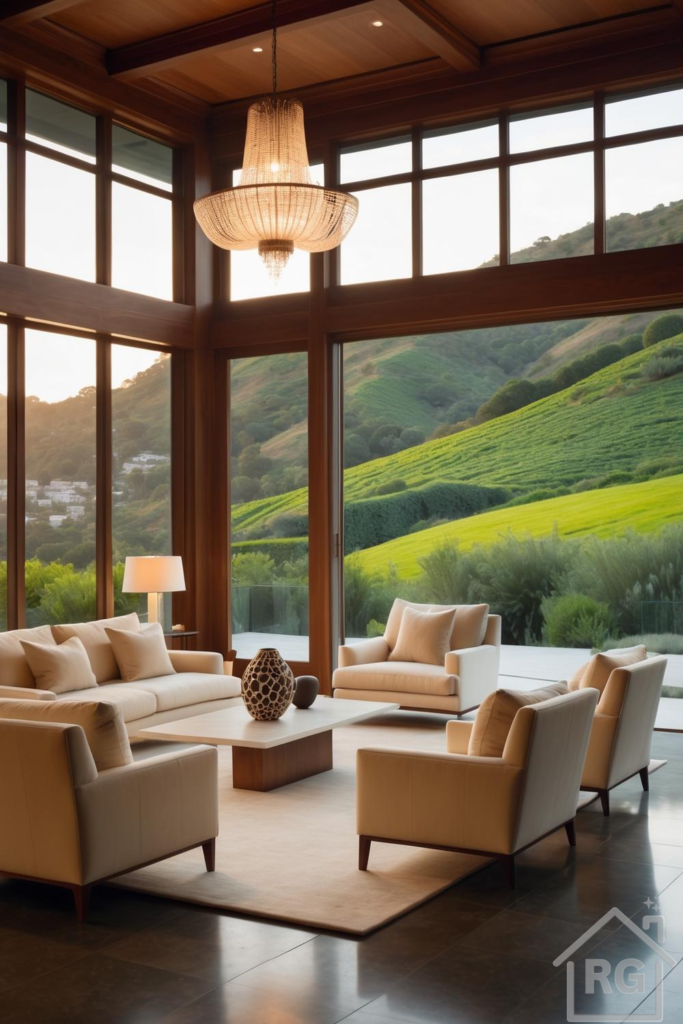
The allure of a room with a view is undeniable. When your windows frame a picturesque landscape, like rolling vineyard hills, the design challenge becomes enhancing, not competing with, the natural beauty outside. This living room masterfully blends sophisticated comfort with the serenity of its surroundings. Achieving this look involves careful consideration of layout, materials, color, and lighting. Let’s explore the key principles to create your own luxurious sanctuary connected to nature.
1. Maximizing the View: The Power of Windows
The most striking feature here is the expansive use of glass. Floor-to-ceiling windows and sliding doors effectively erase the boundary between indoors and outdoors, making the view the undeniable focal point.
Design Tip: Embrace Large Windows
If building or renovating, prioritize large window installations facing the best view. Consider window styles with minimal framing, such as picture windows or modern sliding systems, to avoid obstructing the scenery. Keep window treatments minimal or easily retractable – think sheer roller blinds or curtains that stack neatly to the sides. The goal is an uninterrupted visual connection.
Orientation Matters
Notice how the seating arrangement faces both inwards for conversation and outwards towards the view. This dual focus is crucial. Avoid placing large furniture directly blocking the windows.
2. Layout for Conversation and Contemplation
The furniture arrangement promotes both social interaction and quiet enjoyment of the view. A central seating group, consisting of a sofa and multiple armchairs, is anchored by a large area rug and centered around a coffee table.
Design Tip: Zone and Scale
- Create distinct zones within a large space. Here, the main conversation area is clearly defined. Ensure comfortable pathways for circulation around the furniture.
- The symmetry in placing pairs of armchairs lends a sense of order and calm.
- Consider swivel chairs for flexibility, allowing occupants to easily turn towards the view or conversation.
- The furniture is substantial, matching the scale of the high ceilings and large windows, yet it doesn’t feel overwhelming due to its light color and clean lines.
3. A Palette Inspired by Nature
The color scheme is deliberately muted and sophisticated, drawing inspiration from the natural elements both inside and outside.
- Warm Woods: Rich wood tones on the window frames, ceiling details, and furniture legs provide warmth and echo the trees and earth outside. This creates a grounding effect.
- Creamy Neutrals: The upholstery in shades of beige and cream keeps the space feeling light, airy, and serene. It reflects the natural light beautifully and doesn’t distract from the view.
- Earthy Accents: The dark grey stone tile floor adds depth and contrast, reminiscent of natural stone. The green hills outside provide a vibrant, natural accent color visible through the windows.
Design Tip: Build a Neutral Base
Start with a neutral base (creams, beiges, greys, wood tones). Let the view provide the primary ‘color’. Introduce subtle variations in texture within your neutral palette to add interest. Avoid overly bright or competing colors in the main elements.
4. Layering Textures for Depth and Comfort
While the color palette is restrained, the room feels rich and inviting thanks to a thoughtful mix of textures. This tactile variety prevents a neutral space from feeling flat and adds a layer of understated luxury.
Key Textures Include:
- Smooth glass windows
- Warm wood grain on frames and furniture
- Soft woven upholstery (likely a linen blend or similar natural fiber)
- The cool smoothness of the stone floor
- The plushness of the area rug
- The intricate sparkle of the beaded chandelier
- The textured ceramic vase
Design Tip: Contrast is Key
Pair smooth surfaces (glass, polished stone) with rougher or softer ones (wood grain, woven fabrics, plush rugs). This contrast adds depth and interest.
5. Lighting: Balancing Natural and Artificial
Light plays a crucial role in defining the mood of this space, both day and night.
Natural Light
The design maximizes daylight, making the room feel expansive and connected to the outdoors. The changing light throughout the day becomes part of the room’s dynamic character.
Artificial Light Strategy
A multi-layered approach ensures functionality and ambiance after sunset:
- Statement Chandelier: The large, beaded chandelier acts as a stunning focal point, adding glamour and warm, diffused light. Its intricate texture contrasts beautifully with the clean lines elsewhere.
- Task Lighting: The table lamp provides focused light for reading or specific activities within the seating area.
- Ambient Lighting: Recessed ceiling lights (likely present though not fully visible) would offer overall illumination.
Design Tip: Plan Your Lighting Layers
Plan for different lighting needs: ambient (overall), task (specific activities), and accent (highlighting features). Use dimmers to control the mood. Choose fixtures that complement the room’s style – here, the chandelier adds elegance without being overly ornate.
6. Selecting Key Furnishings and Decor
Each piece contributes to the overall aesthetic of sophisticated comfort. Prioritize quality over quantity and let the view be the star.
- Seating: Choose comfortable, well-proportioned sofas and armchairs with clean lines. Light-colored upholstery enhances the airy feel.
- Coffee Table: A simple, low-profile coffee table with a light top and wood base complements the seating and doesn’t obstruct sightlines.
- Area Rug: A large, neutral rug defines the seating area, adds softness underfoot, and contributes texture.
- Statement Lighting: Invest in a beautiful chandelier or pendant light that acts as a centerpiece.
- Minimal Decor: Accessories are chosen carefully. A single, sculptural vase adds visual interest without cluttering the space.
Design Tip: Focus on Timelessness
Select pieces with timeless appeal and natural materials. Choose furnishings that support, rather than compete with, the magnificent view.
Bringing it All Together
Creating a living room that honors a spectacular view involves a holistic approach. It’s about blurring the lines between inside and out through expansive windows, using a nature-inspired palette and materials, arranging furniture thoughtfully for both conversation and contemplation, layering textures for comfort, and illuminating the space effectively. By focusing on these principles, you can design a luxurious and serene living space that feels deeply connected to the beauty of the natural world.
